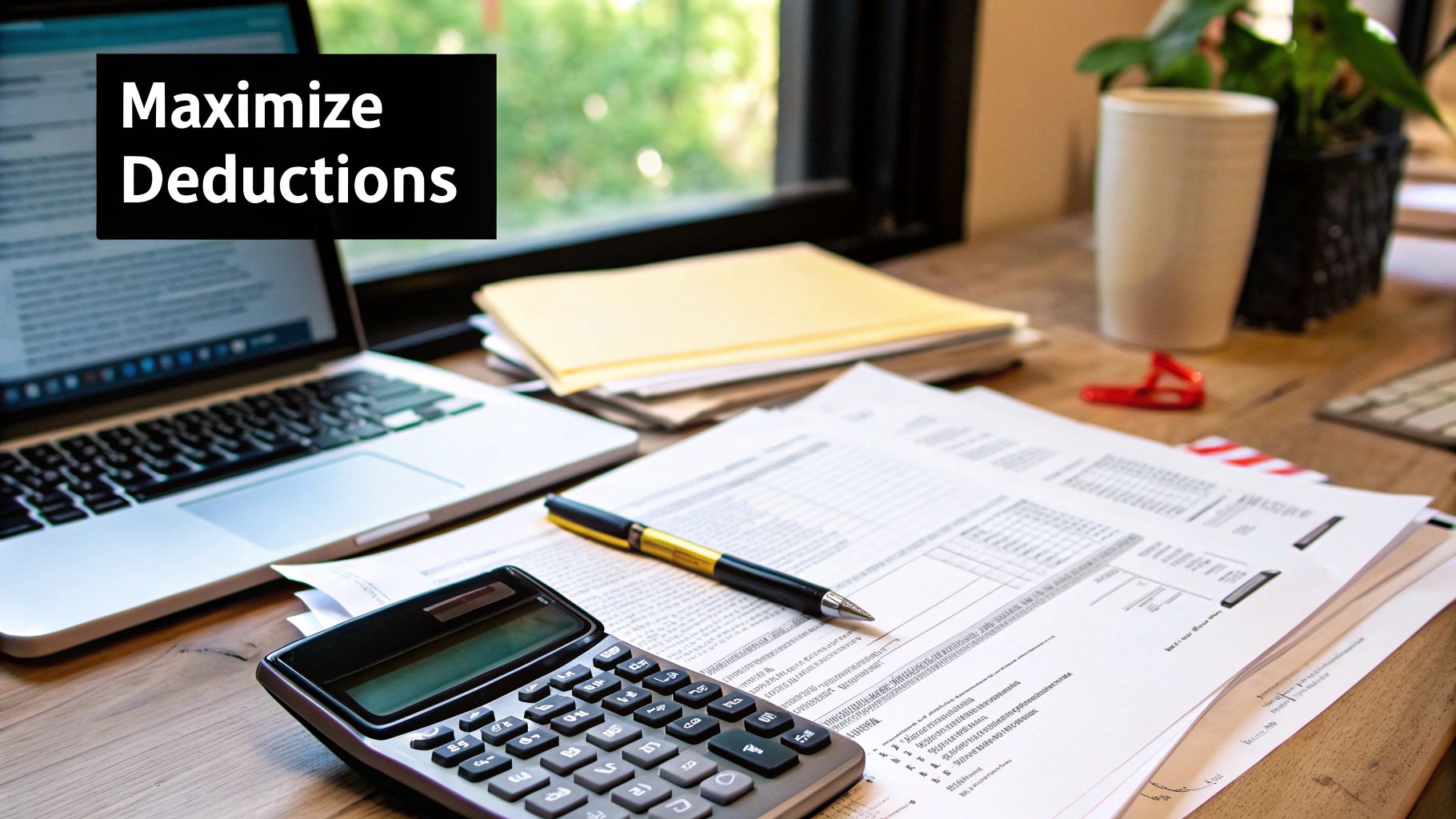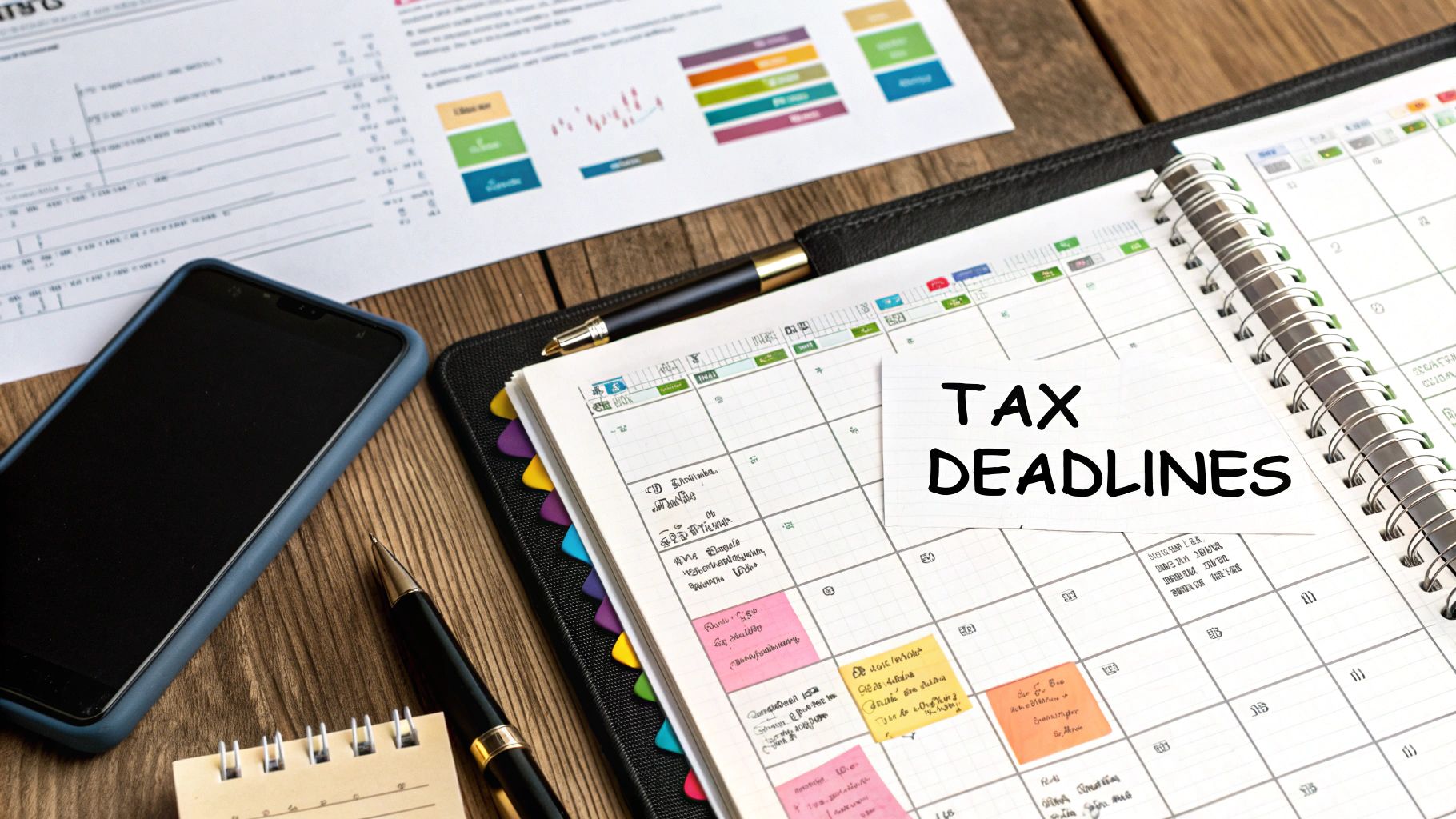
Navigating the Self-Employment Tax Landscape

Managing taxes as a self-employed professional requires a different approach than traditional employment. While employees have taxes automatically withheld from their paychecks, self-employed individuals need to handle tax planning and payments on their own. Understanding how self-employment taxes work is essential for long-term financial health.
Understanding Self-Employment Taxes
As a self-employed person, you’re responsible for paying both Social Security and Medicare taxes – similar to what employees pay, but with a key difference. You must cover both the employer and employee portions, which adds up to a 15.3% tax rate on your net earnings. While this percentage may look daunting at first, several tax benefits can help reduce the burden. For instance, you can deduct half of your self-employment tax from your gross income when filing taxes.
Quarterly Payments: Staying Ahead of the Curve
Self-employed individuals make tax payments four times per year through estimated quarterly payments. These are due on April 15th, June 15th, September 15th, and January 15th of the following year. Staying on top of these payments helps avoid penalties and keeps your finances healthy. Good bookkeeping habits and realistic income projections make this process much smoother. For more guidance, check out: Essential strategies for solo entrepreneurs.
Record Keeping: The Foundation of Tax Success
Keeping detailed records is crucial when you work for yourself. Track all your income and expenses throughout the year, along with documentation for any deductions you plan to claim. Good records not only make tax time easier but also give you clear insights into how your business is performing. Having organized documentation also protects you in case of an audit.
Self-employed workers make significant contributions to the economy. Current projections show they will generate 7.5% of GDP in 2024, up from 6.5% in 2022. This includes their income and payroll tax payments. Learn more in this detailed report: 10 Self-Employment Statistics You Should Know in 2024
By mastering the basics of self-employment taxes, making timely quarterly payments, and maintaining thorough records, you can handle your tax obligations confidently. This allows you to concentrate on what matters most – building and growing your business.
Maximizing Essential Deductions That Drive Real Savings

Smart tax planning is key to keeping more money in your pocket as a self-employed person. Taking advantage of available deductions directly reduces what you owe in taxes, freeing up funds to grow your business or meet personal goals. The key is carefully tracking expenses and understanding which deductions apply to your situation.
The Power of the Home Office Deduction
The home office deduction is one of the most valuable tax benefits for self-employed individuals. When you use part of your home regularly and exclusively for business, you can deduct a portion of your housing costs. This includes a percentage of rent/mortgage interest, utilities, property taxes, and insurance based on the space used. For example, if your office takes up 10% of your home’s square footage, you could deduct 10% of those eligible expenses.
Turning Business Travel Into a Tax Advantage
Business-related travel costs are fully deductible, including flights, hotels, meals, and local transportation. Just be sure to keep detailed records showing each expense’s business purpose. Let’s say you attend an industry conference – your airfare, hotel stay, and other travel costs for that event would typically qualify as deductible business expenses.
Investing in Yourself: Deducting Professional Development
Growing your skills helps both your business and tax situation. You can deduct costs for business-related courses, workshops, training programs, and industry publications. This extends to professional journal subscriptions and conference registration fees. Money spent improving your expertise directly reduces your taxable income.
The Self-Employment Tax Deduction: A Significant Benefit
One major tax break is the self-employment tax deduction. While self-employed people pay both employer and employee portions of Social Security and Medicare taxes (15.3% total), you can deduct 50% of this amount on your tax return. This helps balance out the higher tax burden compared to traditional employees. Learn more: Read about self-employment tax details.
Key Takeaways for Maximizing Deductions
To make the most of these tax benefits, set up a reliable system for tracking business expenses. Use accounting software to organize and categorize your records. Check with a tax professional to ensure you claim all eligible deductions while following tax regulations. Good record-keeping and tax planning will help minimize what you owe and support your long-term success.
Strategic Healthcare Planning for Tax Optimization

Smart healthcare planning is essential for self-employed professionals who want to control costs while maximizing tax benefits. By understanding your options and implementing the right strategies, you can secure quality coverage while reducing your tax burden.
Leveraging Health Savings Accounts (HSAs)
One of the best tools in a self-employed person’s toolkit is the Health Savings Account (HSA). These accounts offer exceptional tax benefits – your contributions are tax-deductible, earnings grow tax-free, and you pay no taxes on withdrawals for medical expenses. For example, you can tap your HSA to cover doctor visits, prescriptions, and other healthcare costs without paying taxes on the money.
Optimizing Insurance Premium Deductions
As a self-employed individual, you can deduct your health insurance premiums from your taxes. This valuable deduction can save you significant money each year by lowering your taxable income. Keep in mind that you cannot take this deduction if you or your spouse can get coverage through an employer. This rule encourages self-employed people to find affordable individual plans and take advantage of premium deductions.
Affordable Care Act (ACA) and Self-Employed Tax Benefits
The ACA has made quality health coverage more accessible for self-employed workers through the ACA Marketplaces. These exchanges have become a vital source of insurance – in fact, 20% of small business owners and self-employed individuals between ages 21-64 got their coverage through the marketplaces in 2022. For more details, check out the Treasury Department’s latest statistics on ACA enrollment. The marketplaces give many self-employed professionals access to subsidized plans they couldn’t get before.
Strategic Healthcare Cost Management
Beyond insurance and HSAs, actively managing your healthcare spending helps maximize tax benefits. Simple steps like negotiating rates with providers, using telemedicine when appropriate, and joining prescription discount programs can reduce your out-of-pocket costs. When you spend less on care, your premium deductions and HSA contributions go further. By combining smart coverage choices with cost-control strategies, you can turn healthcare planning into a key part of your tax and financial strategy.
Building Wealth Through Strategic Retirement Planning

When you work for yourself, planning for retirement takes on new meaning. It’s not just about setting money aside – it’s about making smart choices that reduce your taxes now while growing your wealth for the future.
Understanding Self-Employed Retirement Plans
As a business owner, you have several retirement plan options designed specifically for self-employed individuals. Each offers distinct advantages worth considering carefully.
The Simplified Employee Pension (SEP) IRA lets you contribute and deduct up to 25% of your net earnings from self-employment. For instance, if you make $100,000, you could potentially set aside $25,000 tax-free while lowering your current tax bill.
A Solo 401(k) provides even more flexibility since you can contribute both as an employee and employer. This means you can often save more compared to other plans. For example, in 2024 you could defer up to $23,000 as an employee, plus make additional profit-sharing contributions as the employer.
The Savings Incentive Match Plan for Employees (SIMPLE) IRA offers a more straightforward approach. While contribution limits are lower, the simpler setup and administration make it appealing for many self-employed people just starting their retirement planning.
Choosing the Right Plan for Your Needs
Your ideal retirement plan depends on several key factors. If you’re earning well and want to maximize savings, a Solo 401(k) might be your best bet. But if you prefer a more hands-off approach, a SEP IRA could work better. The best choice aligns with your income level, business structure, and retirement goals.
Timing Your Contributions for Maximum Impact
When you contribute matters as much as how much you contribute. Making contributions early in the year gives your money more time to grow tax-free. Knowing the deadlines for each plan type also helps you avoid penalties while maximizing tax benefits.
Building Long-Term Wealth While Minimizing Taxes
Good retirement planning balances two key goals – reducing taxes today and building wealth for tomorrow. By picking the right plan and timing your contributions well, you create a framework that serves both your current and future financial needs. You might be interested in: How to master remote team management.
Case Studies: Real-World Success
Let’s look at how others have made these strategies work. Take Sarah, a freelance consultant who maxed out her Solo 401(k) contributions. This cut her taxable income substantially while fast-tracking her retirement savings. Or consider Mark, a small business owner who used a SEP IRA to claim major tax deductions each year while steadily building his nest egg. Their experiences show how strategic retirement planning can work for self-employed professionals.
Implementing Year-Round Tax Optimization Strategies
Getting the most out of self-employed tax benefits takes ongoing effort throughout the year, not just at tax time. A smart approach combines organized record-keeping with strategic planning to reduce your tax burden and keep more money in your pocket.
Efficient Bookkeeping Practices
Good bookkeeping forms the base of effective tax management. When you track income and expenses carefully, you can spot all potential deductions and back them up if audited. Start with these essential practices:
- Use Quality Software: Pick accounting software that automatically sorts expenses and creates tax reports. Tools like QuickBooks Self-Employed or FreshBooks make record-keeping simpler and help prevent costly mistakes.
- Keep Business and Personal Separate: Open dedicated business bank accounts and credit cards. This clear division makes expense tracking straightforward and gives you clean records for tax prep.
Strategic Timing for Business Investments
Smart timing of business purchases can reduce your taxes significantly. Consider these timing strategies:
- Year-End Planning: Look at making major equipment or software purchases in December. This lets you claim depreciation deductions sooner rather than later.
- Use Available Tax Breaks: Current tax rules may let you write off a big portion of asset costs right away through bonus depreciation. A new laptop purchase could mean an immediate tax break versus spreading it over several years.
Systematic Documentation: Saving Time and Money
Good documentation helps you claim every deduction you deserve. Here’s how to make it easier:
- Go Digital: Use your phone to scan receipts into cloud storage. Apps like Expensify or Receipt Bank create searchable records so you never lose track of deductions.
- Organize by Category: Label expenses based on their tax category as you record them. This simple step makes tax prep faster and ensures you catch all potential write-offs.
By following these practical steps year-round, you’ll have clean records ready for tax time and confidence that you’re claiming all your legitimate deductions. This organized approach lets you focus on growing your business while keeping tax matters under control.
Avoiding Critical Tax Pitfalls That Cost Entrepreneurs
As a self-employed person, understanding tax benefits is only half the battle. You also need to know how to sidestep common mistakes that can lead to costly penalties and missed opportunities. Getting this right means paying close attention to estimated taxes, properly categorizing expenses, and maintaining detailed records.
Mastering Estimated Tax Payments
Unlike employees who have taxes automatically withheld, self-employed individuals need to calculate and pay taxes quarterly. Many entrepreneurs stumble here, either underpaying (leading to penalties) or overpaying (tying up needed business funds). The key is to make accurate income projections and stick to a quarterly payment schedule. When you get this right, you avoid surprises at tax time and keep your cash flow healthy.
The Importance of Proper Expense Categorization
Mixing personal and business expenses is a common error that can trigger IRS scrutiny. The solution is simple but requires discipline: maintain separate bank accounts and credit cards for your business. This clear division makes tracking expenses straightforward and helps ensure you claim all legitimate deductions. Good record-keeping practices protect you during audits while maximizing your tax benefits. For instance, if you use your vehicle for both business and personal trips, keep detailed mileage logs to accurately claim business use. You might be interested in: How to master starting a business.
Documentation: Your Shield Against Audits
Poor documentation can invalidate legitimate tax deductions. Consider this scenario: you attend a business conference and claim travel expenses, but can’t produce receipts or conference details when asked. Without proper proof, the IRS may reject these deductions, increasing your tax bill. To protect yourself, create a reliable system – scan receipts, label expenses clearly, and organize records methodically. This approach not only safeguards you during audits but ensures you can claim every eligible tax benefit with confidence.
Building a Robust Compliance System
To succeed long-term as a self-employed person, you need reliable systems in place. This means using quality accounting software, working with a skilled tax professional, and keeping up with tax law changes. Taking these steps helps prevent costly mistakes and gives you peace of mind to focus on growing your business.


Leave a Reply